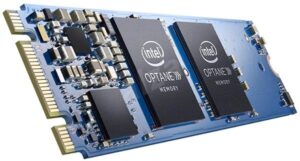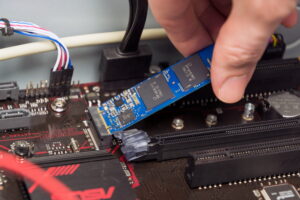Optane Memory
SSDs are always the cheapest. But it can still be difficult to balance everything you would like to get promptly on a single drive. We discourse the option between HDD vs SSD in detail elsewhere. But Intel Optane Memory is looking to close the gap between the fast speed of the hard drive and the status that can be achieved on a mechanical hard drive. If you require some new features to go with Optane, check out our list of the best CPUs, the best graphics cards, and the best SSDs to play. Here’s all you require to know about how Intel Optane Memory works, the advantage, and the potential for conflict.
What is Intel Optane Memory?
Basically, Optane Memory is a form of disk caching. The idea is to give users faster data access for SSDs integrated with high HDD power. (Technically, Optane Memory can also be utilized with an SSD, but for this article, I would just say HDD for faster storage.) Common data repeats on M.2 Optane Memory Storage while data that is less significant and pull from the hard drive. Good in theory, but Optane Memory is not always a good solution.

How Intel OM Works
Optane Memory uses a “newly utilized” (LRU) method to determine what is stored in a fast repository. All first read data comes from slow HDD storage and data copy to the cache. Data writes will be cached and then redirected to the HDD. Each time an archive data block is read or written, the last access time update. Eventually, the cache fills up and the old data eras — and it will be the data that has been unused for too long. Your cache becomes larger, where it can hold more data, and what you can read as well as write will use the cache storage faster than hitting your leisurely HDD.
That raises the tricky question of how big the storage needs to hold all the “important” data. Originally released with 16GB and 32GB capabilities, Intel later added the 64GB Optane Memory option, and you can also use the Intel Optane 800p drive as the largest 118GB OM cache if you choose. The reason for the high power is simple: for some users, the 16GB and 32GB caches are not big enough. Windows 10 alone can use a large bundle of 16GB model data commonly available. Launch a few apps or games and “classic” data cache.
In the worst case, consecutive access of more than 16GB of data (e.g., 17GB) first fills the Optane Memory cache, then removes the old 1GB data to free up the last 1GB of data space. And then clears the entire cache as “new” exclusions reach again.
Any data that is not already in the OM repository ends up with HDD performance, especially counterproductive benefits. This particular situation is unlikely to happen in the real world. A lot of data often use and will benefit from temporary storage – but having enough storage to hold a set of performance data is good.
The trouble comes in determining exactly what is in the original cache. Optane Memory relies on Intel’s Rapid Storage Technology (RST) system and drivers. And RST has some expertise on what types of data are stored in the archive. For example, if you are watching a large HD movie stored on your PC. There is no real benefit to putting all 8GB of movie data in storage. Movies are read consecutively at very low prices (probably 5-15MB / s) and can just waste up storage space.

Intel has not given specific details in its cache storage algorithm, but even a small 16GB Optane Memory module can provide significant improvements in Windows boot times and game loading times. Although most games are now in the range of 50-100GB. At the same time, it is easy to get into an area where the 16GB Optane Memory size limit. AnandTech as an example makes certain benches with and without Optane Memory at various capacities. And large data sets in some tests have caused the 64GB module to return to HDD performance levels.
Intel Optane Memory Specs
Optane memory is usually efficient (all important data is in storage) or only correct (some data is in slow storage). Technically, Optane Memory drives work differently depending on whether you have 16GB, 32GB, or 64GB, models. But I do not generally recommend the 16GB option. Here’s how the three models compare, and also worth pointing out that the Intel Optane 800p SSDs (58GB and 118GB) can also function as Optane Memory drives.
The high sequence height limit by the PCIe x2 interface in high power models, but when done, it doesn’t matter. Few real-world functions will fill the x2 link – copying files can get there, as well as some custom benchmarks. But when you download apps and games OM is much faster.
Optane memory built using Intel’s 3D XPoint technology, a type of non-permanent memory similar to NAND use in many other SSDs. Besides, it relies on modifying physical properties rather than saving costs. First discussed in 2015, 3D XPoint makes many promises. Faster reading and writing speed compared to NAND, higher power, and greater durability. The specs are much better than NAND in terms of quantity, though not as good as the first applications — at least for now.
The green installation of OM is not faster than NAND at present. But one of the major advantages of Optane Memory is low latency access times. When most NAND-based SSDs read/write 100/50µ latencies, OM latency 18/7µ for 32/64GB drives. That’s a big theory, especially since some data access may not be saved so HDD latency works. But when testing the same Intel Optane 800p SSD, overall performance was often better than larger SSDs.


0 Comments